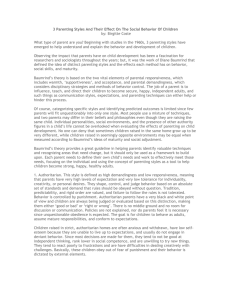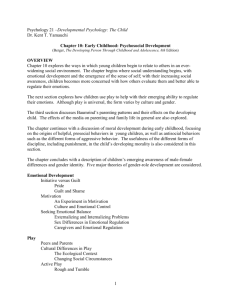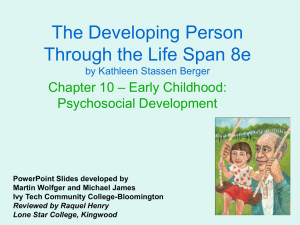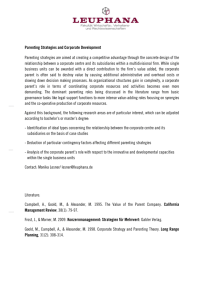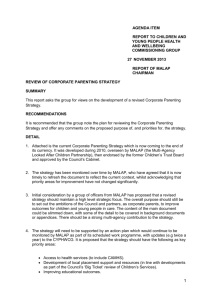Parenting Styles
advertisement
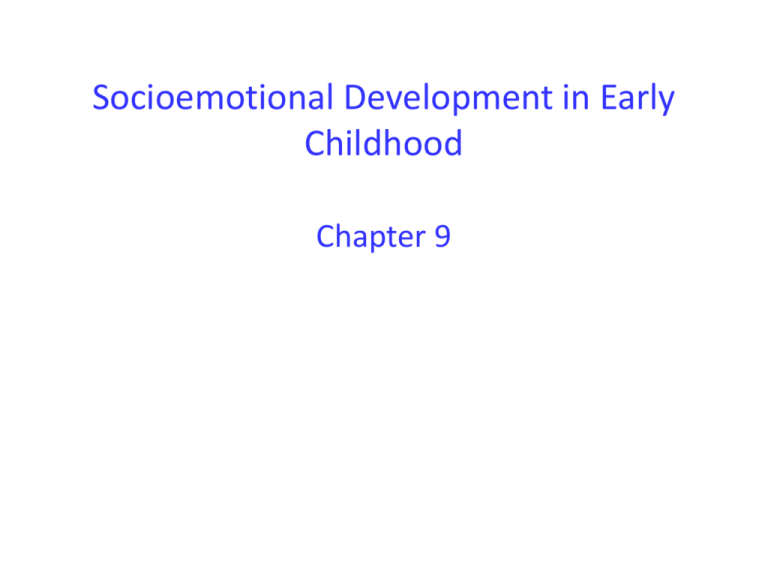
Socioemotional Development in Early Childhood Chapter 9 Self System: How Individuals Think of Themselves (James, 1890) • I-Self – Awareness of self as independent entity – Sense of self as an agent in one’s own destiny – Sense that self can affect others Self System: How Individuals Think of Themselves (James, 1890) • Me-Self – Attributes of self (e.g. age, sex, interests,) – One’s personality • Self-System: – Based on progression of cognitive development – Built on a self constructed working model of self Outcomes of Sense of Self as Agent • The attainment of self-regulation is among the central milestones for the 2- to 3-year-old toddler • [Self Regulation] is a universal developmental goal achieved in all cultures (Kopp, 1982). Cultural Pathways to Self Regulation • Feldman, R & Shafiq Masalha (2006) – Investigated patterns of family interactions among Palestinian families and Israeli families – Observed young children’s self regulation behaviors (e.g. Hill-Soderlund’s research—straight face, strange situation) Cultural Pathways to Self Regulation • Feldman, R & Shafiq Masalha (2006) cont’d – Self-regulation includes two components: • mobilizing a desired response to the requests of socialization agents, and • inhibiting prohibited behavior on command (page 615), – Self-regulation precursors include: • Some aspects of temperament • Culturally-specific parenting strategies Cultural Pathways to Self Regulation • Feldman, R & Shafiq Masalha (2006) cont’d – Individualistic (Feldman & Masalha, 2006) Israeli children, • who received more face-to-face interactions marked by social gaze, • active touch, and • whose parents engaged in more indirect teaching, • showed higher self-regulation Cultural Pathways to Self Regulation • Collectivist (Feldman & Masalha, 2006, pg. 622) For Palestinian toddlers, – more parental contact and – co practice [direct teaching] – predicted self-regulation. Cultural Pathways to Self Regulation • Optimal parenting is defined by the culture • Congruence between the cultural macrosystem and the family microsystem is the variable of interest • Higher congruence is likely to result in better child adaptation to the social world and its rules (Feldman & Masalha, 2006, pg 622). Parenting Styles: Diana Baumrind: • Two dimensions along which Parenting Styles are measured – Responsiveness—warmth, caring, sensitive, supportive – Demandingness—expectations, supervising, monitoring – Resulting matrix contains four prototype parenting styles Parenting Styles: Diana Baumrind: • Authoritarian: – Low responsiveness – High demandingness – Parenting behaviors: • • • • • • Likelihood of high levels of punitive actions High expectations Low support Little involvement in family decisions Decisions are not open to discussion Rationales are not provided Parenting Styles: Diana Baumrind: • Authoritarian: • Child Outcomes – Rigid in thinking and behavior – Lacks problem-solving skills – Tends to turn to peers for support and information (potential for gang, cult involvement) – Likely not eager to make difficult decisions Parenting Styles: Diana Baumrind: Permissive—Indulgent • High responsiveness • Low demandingness Parenting behaviors: • • • • Attempts to respond positively to child’s every request Few rules or boundaries Child is not accountable for behavioral outcomes Child is an active and frequently equal participant in family decisions • Inappropriately involves child in parental lives Parenting Styles: Diana Baumrind: • Permissive—Indulgent – Child Outcomes • Poor emotional control • Low persistence to difficult or unpopular tasks • Frequent externalizing behavior when desires are denied • Poor decision-making skills • Blurred boundaries between child and parent (e.g. relationship is overly egalitarian) Parenting Styles: Diana Baumrind: • Neglectful—Indifferent – Low responsiveness – Low demandingness – Parenting behaviors • Inconsistent discipline based on impact of behavior on parents’ own activities and preferences • Few rules or boundaries • Punishment, when given, can be harsh • Low parental monitoring Parenting Styles: Diana Baumrind: • Neglectful—Indifferent – Outcomes • Low levels of performance in social and academic domains, and frequently poor emotional control • Typically lacks clear understanding of contingency of outcomes on behaviors (little link between behavior and outcome) • May seek out peers for support with little attention to norms of the peer group Parenting Styles: Diana Baumrind: • Authoritative – High responsiveness – High demandingness – Parenting behaviors – Sets consistent and reasonable boundaries for children’s behaviors – Uses reason and discussion as first option for discipline – Low-to-no use of corporal punishment – Models civil discussion – Monitors children’s behaviors, peers, etc., – Allows children’s involvement in family decisions where appropriate – Maintains parental role with little or no enmeshment Parenting Styles: Diana Baumrind: • Authoritative • Child Outcomes – Higher levels of achievement in social and academic domains – Recognizes relationship between behaviors and outcomes—understands contingencies – Adaptive level of emotional control – Develops adaptive decision-making skills – Lower levels of psychological distress (e.g. stress, anxiety, depression) Parenting Styles: • Developmental Themes – Maturity Demands—changing demandingness to meet age appropriate expectations – Democratic Communication—recognize, consider, and react to children’s feelings – Intrusiveness—parental control, enmeshment Disciplining the Child • Punishment in the form of physical, corporal punishment – – – – – Behavior terminated but no new behavior is taught Child tends to repeat behavior and avoids punishment Those parents who were spanked tend to spank Those parents who were abused tend to spank Those mothers who have boyfriends or husbands who hit them, tend to spank – Related to higher levels of aggression among children (who were spanked) – Research mixed with regard to relationship among parenting style, level of severity of punishment and frequency of punishment Disciplining the Child • Positive discipline—shutting the barn door before the horses are out – Parental monitoring – Establish contingencies—clear and consistent rules and limits – Reinforce positive behaviors—when a child is faced with a choice and chooses an appropriate response, praise works. – Use developmentally appropriate explanations and reason – Use principle of extinction in lieu of punishment—remove reinforcers Disciplining the Child • Discipline vs. Punishment – Discipline—teaching appropriate behaviors – Punishment—techniques used to eliminate behaviors • Self-regulation as disciplined behavior – Mobilizing a desired response to requests of socialization agents – Inhibiting a prohibited behavior • Feldman, R & Shafiq Masalha (2006) Erik Erikson’s Stage of Initiative vs. Guilt • Initiative vs. Guilt – Child attempts to achieve goals; – Focus is on goal initiation, not necessarily goal attainment; – Guilt occurs when goal attainment is the focus or when child’s goals are unduly disallowed Self and Emotions • Overall, young children tend to report more positive emotions than negative • Positive emotionality may be based on more social cues • Kochanska, Aksan, Penney, & Doobay (2007) report that in interpersonal tasks (child parent) positive emotionality is positively related to self regulation • Parent may be reinforcing self regulatory behaviors • Somewhat linked to temperament • Boys are reinforced for more positive expressions than negative (sad, depressed) expressions Developing Ideas about Gender: Role and Understanding • Gender is a social role based on a number of biological and social factors • Sex is a biological characteristic; • Gender Role (Sandra Bem): – Feminine—high feminine, low masculine – Masculine—low feminine, high masculine – Androgynous—high feminine, high masculine – Undifferentiated—low feminine, low masculine Developing Ideas about Gender • Process of developing gender roles 1. basic naming and self labeling (I’m a girl, you’re a boy) 2. assessing gender appropriate toys, activities, and traits (appropriate toys, activities, and traits for girls/boys) • Attributions and assessments are based on gender stereotypes – – – • Family models Peers Media Early childhood peer groups tend to be same sex Gender Constancy • Gender remains the same in spite of external changes – Gender identity [identification] – Gender stability [stable over time] – Gender constancy [stable over external physical changes] Kohlberg’s Theory of Moral Development • Moral Decision-making, not the content of the moral decision – Level 1: Preconventional • Self-serving interests • Focus is on outcomes for the individual – Stage 1: Rules followed to avoid punishment; morality is based on decisions that will avoid negative outcomes – Stage 2: Transition from avoiding negative to seeking benefit or reward Kohlberg’s Theory of Moral Development – Level 2: Conventional • Moral decisions are based on societal rules and conventions for being accepted as good members of society – Stage 3: Moral decisions are made in order to manage others’ impressions and maintain their respect; – Stage 4: Moral decisions are made to comply with rule of law and societal rules Kohlberg’s Theory of Moral Development – Level 3: Postconventional • Moral reasoning at this level transcends specific societal or personal rationales and moves to a broader set of principles that transcend time and context – Stage 5: Reasoning here is based on a sense of what is right; rules and laws are seen as malleable based on social contracts – Stage 6: Decisions are based on universal principles that transcend time and context; Rules or Laws that violate these principles are not obeyed Play • Gender-based play segregation – Competing rationales for gender segregation • Gender-based activities • Schematic based choices • Operant conditioning—parents tend to typically reinforce children for gender-appropriate play – Overcoming issues around gender segregated play • Parents model egalitarian relationship in the home • Parents support cross gender play • Teachers create cross gender activities in class Parten’s Levels of Social Play • Unoccupied Play—disengaged, no physical, verbal, or visual engagement with peers • Onlooking Play—observing from afar, visual engagement, focusing, moving for better vantage point, may have verbal engagement • Solitary Play—engaged in solitary play; sustained on task activities, may play in proximity but play activities do not match those of others Parten’s Levels of Social Play • Parallel Play —plays in proximity with other children; activities and objects are the same or similar, but no sharing roles • Associative Play —plays in proximity with other children; focus is on interaction not on coordinating play activities • Cooperative Play —plays in proximity with other children, interacts on the topic of play, division of labor and roles Play • Levels of social play linked to cognitive and social development • Play is a culturally mediated phenomenon based on: – Basic needs met (nutrition, health) – Time (free time away from structured chores) – Availability of peers or peer substitutes
